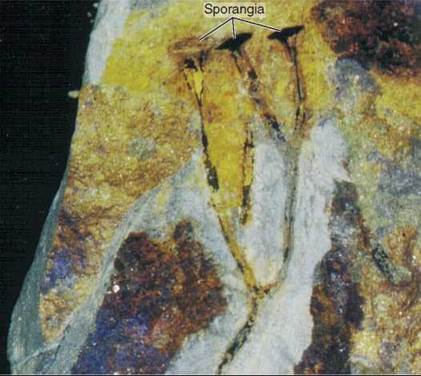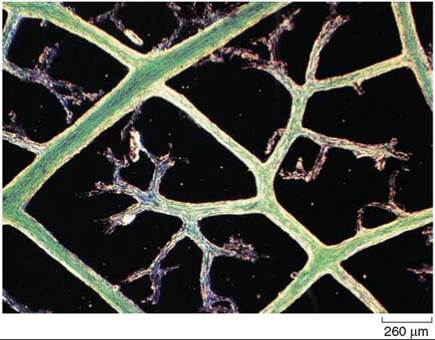THE LIVING WORLD
Unit Seven. Plant Life
32. Evolution of Plants
32.4. The Evolution of Vascular Tissue
The remaining seven phyla of plants, which have efficient vascular systems made of highly specialized cells, are called vascular plants. The first vascular plant appeared approximately 430 million years ago, but only incomplete fossils have been found. The first vascular plants for which we have relatively complete fossils, the extinct phylum Rhyniophyta, lived 410 million years ago. Among them is the oldest known vascular plant, Cooksonia. The fossil in figure 32.6 clearly shows that the plant had branched, leafless shoots that formed spores at the tips in structures called sporangia.

Figure 32.6. The earliest vascular plant.
The earliest vascular plant of which we have complete fossils is Cooksonia. This fossil shows a plant that lived some 410 million years ago; its upright branched stems terminated in spore-producing sporangia at the tips.
Cooksonia and the other early plants that followed became successful colonizers of the land through the development of efficient water-and food-conducting systems known as vascular tissues (Latin, vasculum, vessel or duct). These tissues, discussed in detail in chapter 33, consist of strands of specialized cylindrical or elongated cells that form a network of tubelike structures throughout a plant, extending from near the tips of the roots (when present), through the stems, and into the leaves (when present; figure 32.7). One type of vascular tissue, xylem, conducts water and dissolved minerals upward from the roots; another type of vascular tissue, phloem, conducts carbohydrates throughout the plant. The presence of a cuticle and stomata are also characteristic of vascular plants.

Figure 32.7. The vascular system of a leaf.
The veins of a vascular plant contain strands of specialized cells for conducting food and water.
Most early vascular plants seem to have grown by cell division at the tips of the stem and roots. Imagine stacking dishes—the stack can get taller but not wider! This sort of growth is called primary growth and was quite successful. During the so-called Coal Age (between 350 and 290 million years ago), when much of the world’s fossil fuel was formed, the lowland swamps that covered Europe and North America were dominated by an early form of seedless tree called a lycophyte. Lycophyte trees grew to heights of 10 to 35 meters (33 to 115 ft), and their trunks did not branch until they attained most of their total height. The pace of evolution was rapid during this period, for the world’s climate was changing, growing dryer and colder. As the world’s swamplands began to dry up, the lycophyte trees vanished, disappearing abruptly from the fossil record. They were replaced by tree-sized ferns, a form of vascular plant that will be described in more detail in section 32.5. Tree ferns grew to heights of more than 20 meters (66 ft) with trunks 30 centimeters (12 in) thick. Like the lycophytes, the trunks of tree ferns were formed entirely by primary growth.
About 380 million years ago, vascular plants developed a new pattern of growth, in which a cylinder of cells beneath the bark divides, producing new cells in regions around the plant’s periphery. This growth is called secondary growth. Secondary growth makes it possible for a plant stem to increase in diameter. Only after the evolution of secondary growth could vascular plants become thick-trunked and, therefore, tall. Redwood trees today reach heights of up to 117 meters (384 ft) and trunk diameters in excess of 11 meters (36 ft). This evolutionary advance made possible the dominance of the tall forests that today cover northern North America. You are familiar with the product of plant secondary growth as wood. The growth rings that are visible in cross sections of trees are zones of secondary growth (spring-summer) spaced by zones of little growth (fall-winter).
Key Learning Outcome 32.4. Vascular plants have specialized vascular tissue composed of hollow tubes that conduct water from the roots to the leaves. Another type of vascular tissue forms cylinders that conduct food from the leaves to the rest of the plant.